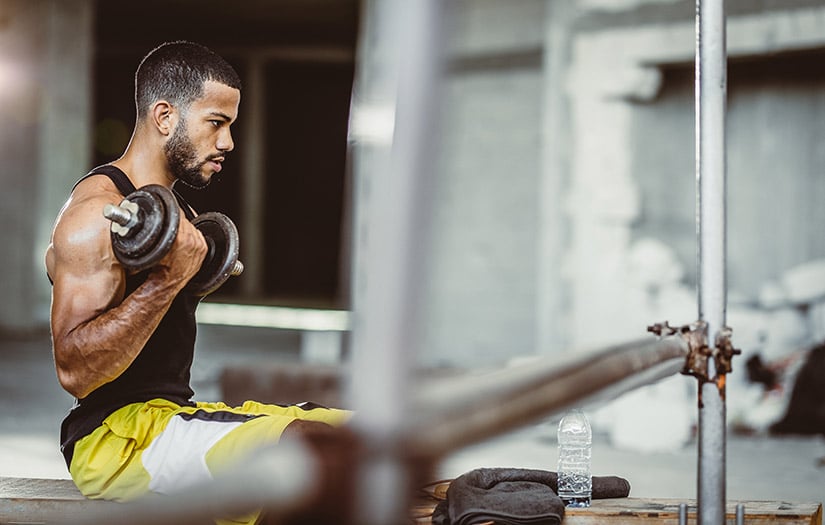There are many reasons why someone might decide to start lifting weights, but one of the most common reasons is to lose weight. Consistent exercise, good nutrition, and adequate sleep are critical components of any weight loss plan, and a healthy combination of each of these three is necessary to see success.
That being said, this article will focus on the exercise component of weight loss, specifically, the benefits of including strength training in a weight loss program.
See our mini course about The Science Behind Effective Weight Loss for additional insights into weight loss strategies. And if you are tracking your calories, NASM has a free tool for that.
Is lifting weights good for weight loss?
If your goal is to lose weight, how does lifting weights help in that endeavor? First of all, strength training is a great form of exercise and an excellent way to burn calories. Additionally, lifting weights can help you maintain and build muscle mass. The reason that this is such a benefit to someone trying to lose weight is the fact that muscle tissue burns more calories than fat.
It's also important to know that muscle tissue is more dense than fat. This means that 1 pound of muscle will take up less space than 1 pound of fat in your body. Over the years, I've noticed that my clients who lose body fat during a strength training program don't see their weight on the scale change as much as their physical appearance has changed.
They've dropped pant sizes and even look the way they wanted to when they set their goals, but the number on the scale is higher than they expected. Don't panic! When you decrease your body fat percentage and increase muscle mass in a strength training program, it's normal not to see the number on the scale drop dramatically.
What Weight Training is Best for Weight Loss?
For weight loss, it’s important to choose a strength training program that is efficient in burning calories while also helping you increase muscle and decrease body fat. Phases 1 and 2 of the NASM OPT model do just that.
Phase 1: Stabilization Endurance Training commonly uses circuits. In a circuit you go from one exercise to the next with little to no rest. Working in circuits during this phase will keep the heart rate elevated to increase the caloric burn during sessions.
Phase 2 of the OPT Model: Strength Endurance Training uses supersets. A superset is a group of two exercises performed back-to-back with little to no rest between sets. These phases of training are intended to help you build stability and strength as you work toward your weight loss goals.
6 of the Best Weight Lifting Exercises for Weight Loss
Compound exercises are ideal when it comes to choosing exercises that will help aid weight loss. A compound exercise will involve the movement of multiple joints at once, which means that multiple muscles or muscle groups are involved in the movement. This results in higher calorie burn in the exercise itself and it means that you don’t have to do as many exercises to do a full-body workout. Winning!
In addition to compound exercises, it’s great to select a variety of movements to help you construct a full-body workout. Including a push, pull, hinge, squat, lunge, and rotational movement in each workout will keep your training program efficient and well-balanced. Here are some Phase 1 and Phase 2 examples of these movements:
Phase 1 Exercises
#1 Push-up
The Move: Start in a high-plank position with your hands underneath your shoulders and feet hip-width apart. Your body should be in a straight line from your head to your toes, and it should stay that way during the entire movement. Keep your abs and glutes tight as you bend the elbows to lower your chest toward the ground. Exhale as you press up to the starting position.
The Tempo: Go slow on the way down (about 4 seconds), stop at the bottom, and hold for 2 seconds, press up in 1 second.
Progressions: Start by doing push-ups on an elevated surface like a wall, countertop, or bench. The lower you go, the more challenging this move will be!
See also: How to do a Pushup with Proper Form
#2 Suspension Trainer Row
The Move: Face the anchor and hold the straps with your palms facing in toward one another. Start with your arms straight, with tension in the rope, and walk your feet forward until you're standing at an angle leaning back. Your body should be in a straight line.
Pull your body up toward the anchor while keeping your elbows close to your body. Row until your wrists are next to your rib cage and squeeze your shoulder blades together at the top. Slowly return to the starting position.
The Tempo: One second to row up, squeeze and hold for 2 seconds at the top, 4 seconds to lower back to starting position.
Progressions: Walk your feet forward toward the anchor to make this move harder.
#3 Glute Bridge
The Move: Lay on your back with your knees bent, feet hip-width apart, and arms at your sides with your palms up toward the ceiling. Squeeze the glutes and lift the hips up until your shoulders, hips, and knees are in a straight line. Lower down to the starting position.
The Tempo: One second to bridge up, squeeze and hold for 2 seconds at the top, 4 seconds to lower back to starting position.
Progressions: Progress by lifting a leg at the top of the movement. The goal is to keep the hips neutral at all times.
#4 Ball Squat
The Move: Lean against a ball on a wall with the ball on your lower back. Sit your hips straight down into a squat until the thighs are parallel with the ground. Push through the heels and squeeze the glutes to stand.
The Tempo: 4 seconds to lower into the squat, pause for 2 seconds at the bottom of the squat, one second to stand.
Progressions: Progress to free-standing squat with good form (not leaning too far forward or arching back)
#5 Step-up to Balance
The Move: Choose a step that's 8-12 inches high to start with. Step up and raise the opposite knee up to hip height. Squeeze the glutes on the standing leg while you balance. Step all the way down to the starting position.
The Tempo: One second on the step up, two seconds to balance and hold at the top, 4-second descent on the way down.
Progressions: Increase the height of the step gradually, or change the plane of motion (forward, side, rotating).
#6 Pallof Press
The Move: Hold a cable or band so that your straight arms are perpendicular to the band. Your feet should be hip-width apart with good posture and tight glutes and abs. Pull the handle close to your body and press it away without allowing your body to rotate.
The Tempo: 4 seconds as you pull the handle close to you, 1 second as you press it away, and 2-second hold with your arms straight.
Progressions: Narrow your base and progress to eventually standing on one foot during the press. You'll stand on the foot closest to the anchor.
How Many Times a Week Should You Weight Lift for Weight Loss?
According to the CDC Physical Activity Guidelines for Americans, it's important to get either 150 minutes of moderate-intensity aerobic activity (like brisk walking) or 75 minutes of vigorous-intensity aerobic activity (like jogging or running) per week AND two or more days of strength training per week.
While these recommendations are for general health, they're also a great starting place for anyone trying to lose weight.
Lifting weights 2-3 times a week will allow you to have sufficient recovery between strength training days while helping you progress in your goals.
For example, someone might lift weights on Tuesdays/Fridays if they do twice a week or do Monday/Wednesday/Friday if they choose 3 days a week. The key is to find a schedule that's realistic and sustainable for you! Consistent effort over time will yield the results you're looking for.
How Much Weight Should I Lift to Lose Weight
For Phase 1 Stabilization Endurance Training, you’ll work in a rep range of 12-20 reps for 1-3 sets at a slow tempo (4-2-1). In Phase 2 Strength Endurance Training, you’ll perform 8-12 reps for 2-4 sets.
When choosing the weight to use during an exercise, you want a weight that allows you to perform all reps with good form. You will probably feel a burn during the last 3-4 reps, and your muscles might even shake a little bit, but you should still have good control over the movement.
As you get stronger, you can use the 2 for 2 rule to know when to add weight. If you can do two additional reps with good form for 2 sets in a row, then it’s time to increase the weight! Start lighter than you think you need (especially when you are in Phase 1- that tempo is no joke!), and progress as needed. Remember, good form is more important than the amount of weight that you’re lifting!
Here are example workouts for Phase 1 and Phase 2:
Lifting Plan for Weight Loss
#1 Circuit Training workout for Weight Loss
Perform these exercises in a row with little to no rest in between. Rest 60 seconds between circuits.
| Exercise | Reps | Sets | Tempo |
| Push-up | 12-20 | 1-3 | 4-2-1 |
| Step-up to Balance | 12-20 | 1-3 | 4-2-1 |
| Suspension Trainer Row | 12-20 | 1-3 | 4-2-1 |
| Ball Squat | 12-20 | 1-3 | 4-2-1 |
| Glute Bridge | 12-20 | 1-3 | 4-2-1 |
| Pallof Press | 12-20 | 1-3 | 4-2-1 |
#2 Superset Workout for Weight Loss
Perform each exercise in the superset back to back with little to no rest. Perform all reps/sets of the superset before moving on to the next superset.
| Exercise | Reps | Sets | Tempo |
| Single Arm Row/Suspension Trainer Row | 8-12 | 2-4 | 2-0-2/4-2-1 |
| Dumbbell Squat/Step up to Balance | 8-12 | 2-4 | 2-0-2/4-2-1 |
| Bench Press/Push-up | 8-12 | 2-4 | 2-0-2/4-2-1 |
| Wood Chop/Pallof Press | 8-12 | 2-4 | 2-0-2/4-2-1 |
Once you've spent 4 weeks in Phase 1 and then 4 weeks in Phase 2, you can start the cycle over. Each time you cycle through, look for new ways to challenge yourself! This might look like new balance challenges in Phase 1 and then heavier weights in the strength exercises in Phase 2. You should notice that you continue to progress little by little each time you repeat, and the results will speak for themselves.
Remember, Rome wasn't built in a day, and your ideal physique won't be either. When it comes to weight loss and seeing results, consistency is key! Find the workout schedule that works best for you and commit to 8-12 weeks of consistently eating well, working out, and getting sufficient rest. It will be worth it!
References:
“How Much Physical Activity Do Adults Need?” Centers for Disease Control and Prevention, Centers for Disease Control and Prevention, 7 Oct. 2020, www.cdc.gov/physicalactivity/basics/adults/index.htm.

















